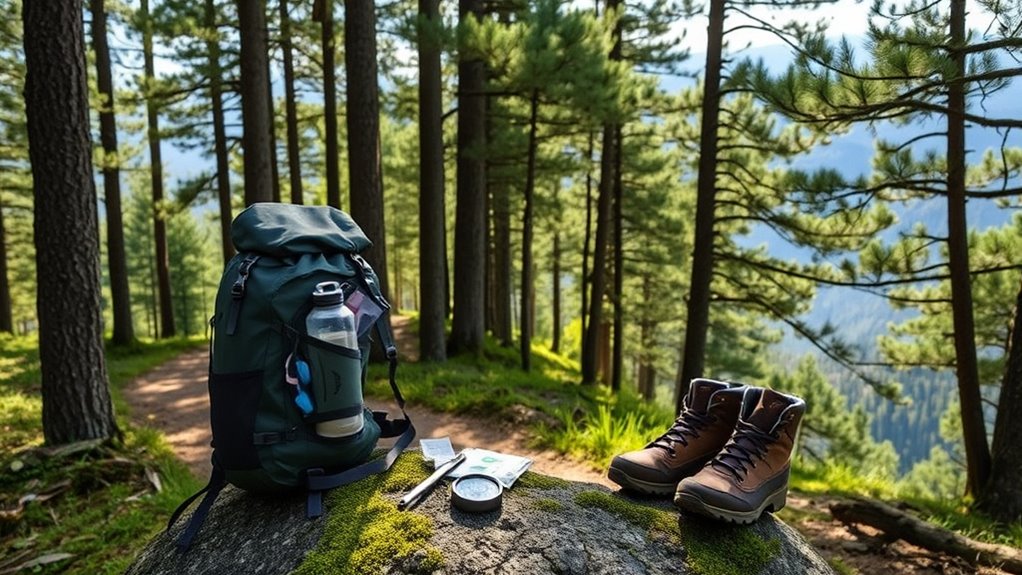When hiking, always inform someone of your route and expected return, and be prepared with a first aid kit, map, and compass. Wear sturdy boots and dress in layers for comfort. Stay on marked trails and practice Leave No Trace principles. Keep a safe distance from wildlife and never feed them. Prioritize your safety by trusting your instincts and turning back if needed. There’s so much more to discover about enhancing your hiking adventures.
Key Takeaways
- Always inform someone of your hiking route and expected return time for safety.
- Wear sturdy hiking boots and dress in layers for comfort and protection.
- Carry a first aid kit, water, snacks, and navigation tools like a map and compass.
- Stay on marked trails and practice Leave No Trace principles to protect the environment.
- Keep a safe distance from wildlife and avoid feeding animals to preserve their natural behavior.

Have you ever wondered how to make the most of your hiking experience? Whether you’re a beginner or just looking to sharpen your skills, understanding trail safety and essentials can make all the difference. First and foremost, you need to be prepared for anything. Emergency preparedness isn’t just a buzzword; it’s a critical aspect of any hike. Having a plan can save your life. Always let someone know your route and expected return time. Carry a first aid kit, a map, and a compass, even if you’re using a GPS. Technology can fail, and getting lost can happen to anyone.
Be prepared for anything on your hike; having a plan and essential gear can make all the difference.
Packing the right gear is essential. Ensure you wear sturdy hiking boots and dress in layers to adapt to changing weather conditions. Bring plenty of water and snacks to keep your energy up. A hydration system or water bottles should be part of your essentials. When you’re out in nature, you might be tempted to take shortcuts or stray from the trail. Resist that urge! Staying on marked paths not only protects you from getting lost but also helps preserve the environment.
Speaking of preservation, practicing Leave No Trace principles is vital for every hiker. This means you should pack out everything you bring in, including trash and leftover food. Stick to established campsites and trails to minimize your impact on the natural surroundings. When you respect nature, you guarantee that future generations can enjoy the same beauty you do today. Additionally, consider bringing along some tableware to enjoy meals in a more organized manner during your hikes.
If you encounter wildlife, keep a safe distance. Feeding animals can alter their natural behaviors and put both you and them at risk. Remember, you’re a visitor in their home. Observing from afar is the best way to appreciate the diverse wildlife you might encounter.
As you set out on your hiking journey, remember that preparation is key. The better prepared you are, the more enjoyable your hike will be. Make a checklist before heading out, and review it thoroughly. Stay aware of your surroundings and listen to your instincts. If something doesn’t feel right, don’t hesitate to turn back.
Ultimately, hiking is about connecting with nature and enjoying the fresh air. By prioritizing safety, practicing Leave No Trace, and being prepared for emergencies, you’ll create lasting memories while protecting the beauty of the great outdoors. So lace up those boots, hit the trail, and maximize your hiking experience!
Frequently Asked Questions
What Should I Do if I Encounter Wildlife on the Trail?
If you encounter wildlife on the trail, stay calm and don’t approach the animal. Back away slowly while keeping your eyes on it. Make noise to alert the animal of your presence, but don’t yell or make sudden movements. If it’s a large animal, like a bear or moose, follow specific safety precautions for that species. Always respect wildlife and their space—this keeps you safe and guarantees the animals remain undisturbed.
How Can I Prevent Getting Lost While Hiking?
To prevent getting lost while hiking, you should start by studying the map before you hit the trail. Pay attention to trail markers along the way; they’ll guide you and help you stay on course. Keep your map handy, and don’t hesitate to check it if you feel uncertain. If you’re venturing into unfamiliar territory, consider using a GPS device or a hiking app for extra security. Always trust your instincts!
Are There Specific Hiking Shoes or Boots I Should Consider?
When hiking, 70% of hikers say the right footwear makes a huge difference in comfort and safety. You should consider investing in quality hiking footwear, like trail shoes or boots that provide support and traction. Trail shoes are lightweight and perfect for well-maintained paths, while boots offer more support for rugged terrain. Make sure they fit well; a comfortable fit reduces the risk of blisters and enhances your overall hiking experience.
What Should I Pack for a Day Hike Versus an Overnight Hike?
For a day hike, pack trail food like energy bars, fruits, and nuts, along with hydration gear such as a water bottle or hydration pack. Don’t forget a map and first aid kit. For an overnight hike, add a tent, sleeping bag, and cooking gear to your day hike essentials. Bring extra trail food, hydration gear, and weather-appropriate clothing to stay comfortable. Enjoy your adventure and stay safe!
How Do I Find the Best Hiking Trails in My Area?
To find the best hiking trails in your area, start by checking local parks and recreation websites. Use apps like AllTrails or TrailLink to explore options based on trail difficulty and accessibility. You can also join local hiking groups on social media for recommendations. Don’t forget to read reviews from fellow hikers to gauge what to expect. With a little research, you’ll discover trails that match your skill level and preferences!
Conclusion
So, you’re all set to conquer the great outdoors, armed with your gear and a trusty map. You might think you’ve got everything under control, but remember, Mother Nature has her own plans. Embrace the unexpected—like a surprise rain shower or a friendly bear encounter! With a little preparation and a dash of humor, you’ll navigate those trails like a pro. After all, what’s a hike without a little adventure? Happy trails, and don’t forget to breathe!










